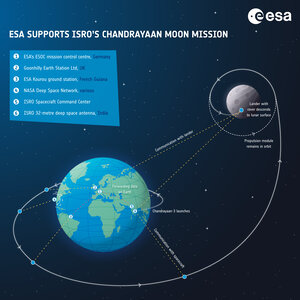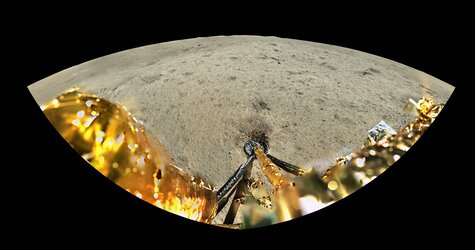ESA stations support three Moon missions in 2024
Happy International Moon Day!
ESA’s network of satellite communication stations – Estrack – continues to connect Earth and the Moon in 2024. ESA stations are supporting three new and returning partners this year: one of them carried ESA’s first scientific instrument to the lunar surface and another will deploy the first Moon rover made in Europe.
The first commercial Moon landing

The Intuitive Machines IM-1 mission, part of NASA’s Commercial Lunar Payload Services initiative, became the first private endeavour to softly land on the Moon on 22 February 2024.
Norwegian company Kongsberg Satellite Services (KSAT) provided the communication services that connected the spacecraft to Intuitive Machines mission control on Earth.

KSAT provided support from five of their own and partner antennas, one of which was ESA’s 15 m antenna in Kourou, French Guiana. Kourou station provided five support sessions to IM-1: three shortly after launch, one during lunar approach, and one to downlink data gathered on the lunar surface.
“Supporting the IM-1 mission was a valuable experience for us,” says Adrian Segura Cabrera, ESA Ground Operations Engineer. “Kourou station is involved in an increasing number and diversity of Moon missions and this activity demonstrated our ability to support a new generation of lunar exploration.”
Lunar sample return and European science

Kourou station was also responsible for receiving the first signals from the Chinese Chang’e-6 lunar sample return mission after it launched on 3 May. These signals were used by the spacecraft’s operators to determine its exact location and to verify its health after the mechanical stress of lift-off.
The Chang’e-6 mission carried a number of European payloads, including ESA’s first scientific instrument to operate on the surface of the Moon.
The Negative Ions at the Lunar Surface, built for ESA by Swedish Institute of Space Physics, successfully detected the presence of negative ions on the lunar surface for the first time.

On 25 June, Chang’e-6 returned almost two kg of samples from the far side of the Moon. ESA tracked the reentry module during its approach using Maspalomas station, operated by the Spanish Instituto Nacional de Tecnica Aerospacial as part of the extended Estrack network.
Tracking the module shortly before it reentered the atmopshere at high speed required high-precision antenna operations and helped the Chang'e-6 team predict where and when the sample capsule would land.
Japanese lander to deploy rover made in Europe
Later this year, Japanese Moon exploration company ispace will launch its HAKUTO-R Mission 2. The company will rely on ESA’s ground stations to maintain contact with the spacecraft.
“We have completed our validation tests and are ready to provide tracking and communication support from launch to landing and throughout surface operations,” says Gerhard Billig, Service Manager at ESA’s ESOC mission operations centre in Germany.

The Mission 2 lander, called RESILIENCE, will carry a lightweight, carbon-fibre lunar rover developed in Europe and co-funded by Luxembourg’s LuxIMPULSE programme through an ESA contract. The rover will demonstrate lunar sample collection technology as part of a project carried out by ispace EUROPE S.A. for NASA.
ispace Europe was established in Luxembourg in 2017 and serves as ispace’s primary point of contact with ESA.







